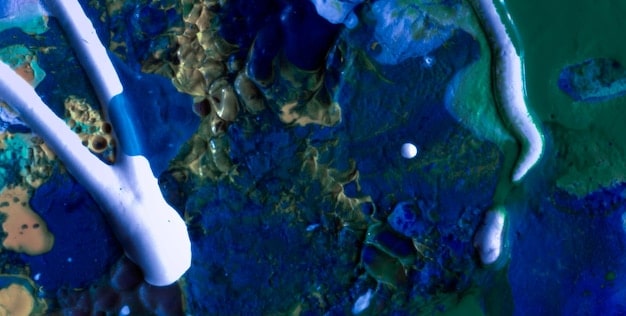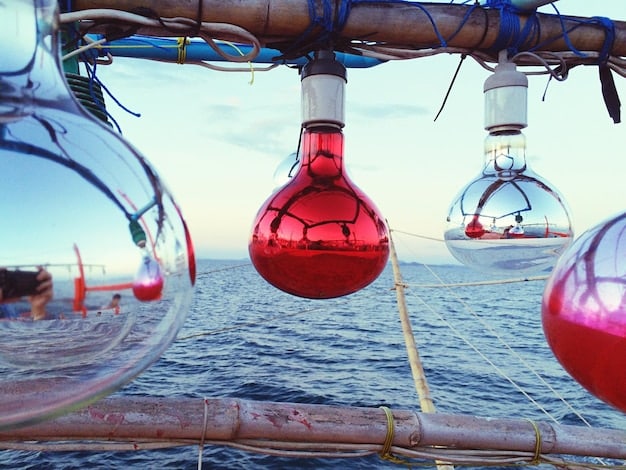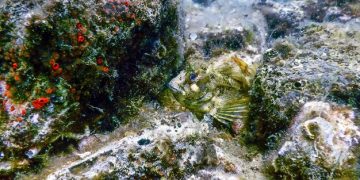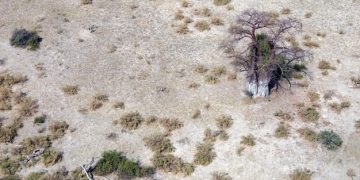Ocean Acidification’s Impact on US Fisheries: Latest Studies & Management Implications

The latest scientific studies on ocean acidification reveal profound implications for US fisheries management, necessitating adaptive strategies to protect marine ecosystems and the economic livelihoods they support from escalating pH declines.
The intricate balance of our oceans is facing an unprecedented threat, with far-reaching consequences for marine life and human economies alike. Understanding What are the Implications of the Latest Scientific Studies on Ocean Acidification for US Fisheries Management? is not merely an academic exercise; it is an urgent imperative for policymakers, scientists, and the fishing communities across the United States. This article delves into the cutting-edge research, exploring how a subtle chemical shift in seawater pH is poised to reshape America’s vital aquatic landscapes.
Understanding Ocean Acidification: The Core Science
Ocean acidification, often termed “the other CO2 problem,” refers to the ongoing decrease in the pH of the Earth’s oceans, caused by the uptake of atmospheric carbon dioxide (CO2). More than a quarter of the CO2 released by human activities into the atmosphere is absorbed by the ocean. This absorption initiates a series of chemical reactions, leading to an increase in hydrogen ions and, consequently, a decrease in seawater pH.
For decades, oceans have diligently absorbed excess CO2, acting as a crucial carbon sink. Yet, this service comes at a significant cost. The average pH of surface ocean waters has already fallen by 0.1 units, representing approximately a 30% increase in acidity since the beginning of the Industrial Revolution. Projections indicate a further decrease of 0.3 to 0.4 pH units by the end of this century if CO2 emissions continue unchecked. These seemingly small changes are monumental on geological timescales and have profound effects on marine chemistry and biodiversity.
The Chemistry Behind the Change
When CO2 dissolves in seawater, it forms carbonic acid (H2CO3). This weak acid then dissociates, releasing hydrogen ions (H+) and bicarbonate ions (HCO3-). The increase in H+ ions directly lowers the pH, making the water more acidic. Critically, this process also reduces the concentration of carbonate ions (CO32-), which are essential building blocks for shellfish, corals, and other calcifying organisms. This reduction in available carbonate ions makes it harder for these organisms to form and maintain their shells and skeletons, a process known as calcification.
The impact of reduced carbonate saturation manifests in various ways across marine ecosystems. From tiny pteropods—”sea butterflies” that form a crucial part of the food web—to massive coral reefs, the ability to build and maintain fundamental structures is compromised. This has cascading effects, altering food webs and potentially disrupting the delicate balance of entire marine environments. Understanding these chemical shifts is the bedrock upon which effective management strategies must be built.
- Reduced carbonate ions hinder shell and skeleton formation.
- Increased acidity directly impacts marine organism physiology.
- Disruption of vital calcification processes.
- Cascading effects on marine food web dynamics.
The scientific community continues to refine models and conduct experiments to fully grasp the intricate chemical and biological interplay. Early studies often focused on individual species, but more recent research explores ecosystem-level responses, including how multiple stressors might interact, such as rising temperatures and deoxygenation alongside acidification. This holistic understanding is crucial for developing robust management policies.
Impacts on Key US Fishery Species: New Revelations
The latest scientific studies provide increasingly granular insights into how ocean acidification directly threatens commercially important US fishery species. While initial research often focused on calcifying organisms like oysters and clams, a broader range of species, including finfish, are now understood to be vulnerable. These impacts extend beyond simple shell dissolution, affecting critical life stages and behaviors.
Shellfish industries, particularly those in the Pacific Northwest, have already witnessed firsthand the devastating effects of acidified waters. Oyster hatcheries, for instance, have reported massive die-offs of larvae due to corrosive conditions. These early life stages are exceptionally sensitive, as they rely heavily on available carbonate ions for rapid shell development. Survival rates plummeting in hatcheries translate directly to reduced stock for aquaculture and wild fisheries, having significant economic repercussions.
Crustaceans and Finfish: Expanding Vulnerabilities
While often more resilient than bivalves, crabs, lobsters, and other crustaceans are not immune. Research indicates that ocean acidification can weaken their carapaces, making them more susceptible to predation and disease. For species like the Dungeness crab, a cornerstone of West Coast fisheries, this poses a considerable threat. Studies show that even subtle changes in pH can impact their growth rates and ability to detect predators, leading to compromised survival.
Surprisingly, finfish, traditionally thought to be less vulnerable, are also exhibiting significant impacts. Recent findings demonstrate that ocean acidification can impair their sensory abilities, including their sense of smell, crucial for finding food, avoiding predators, and navigating. Some studies even suggest compromised hearing and vision. For economically vital species such as Atlantic cod, Pacific salmon, and various groundfish, these behavioral changes can disrupt breeding patterns, migratory routes, and ultimately, population dynamics. These subtle yet critical effects underscore the pervasive nature of acidification’s threat.
- Oyster larvae mortality significantly increases in acidic waters.
- Crab and lobster carapace strength can be compromised.
- Finfish exhibit impaired sensory functions, like smell and hearing.
- Disruption of reproductive and migratory behaviors in key species.
Beyond individual species, the alteration of entire food webs is a growing concern. If the base of the food web—like pteropods or certain plankton—is compromised, it has direct consequences for predator species, including many of the fish we consume. These newly revealed vulnerabilities highlight the complexity of the issue and the need for a comprehensive, ecosystem-based approach to fisheries management.

Economic Implications for US Fisheries: A Looming Crisis
The economic backbone of many coastal communities across the United States is intrinsically tied to healthy marine ecosystems and thriving fisheries. As ocean acidification intensifies, the direct impacts on marine species translate into significant, tangible economic losses for the US fisheries sector. This isn’t merely an environmental problem; it is a profound economic challenge demanding urgent attention from policymakers and industry stakeholders alike.
The ripple effect of reduced fish and shellfish populations extends throughout the supply chain. From the independent fisherman struggling with smaller catches to large commercial operations facing increased operating costs and reduced yield, the financial strain is evident. Processors, distributors, and even local restaurants and tourism industries that rely on fresh seafood are susceptible to these economic pressures, creating a cascading impact on regional economies. The stability of hundreds of thousands of jobs across the country, linked directly and indirectly to the fishing industry, is at stake.
Costs of Adaptation and Mitigation
Beyond the direct loss of harvest, the industry faces mounting costs associated with adaptation and mitigation efforts. For aquaculture, this might involve investing in water chemistry monitoring systems, developing more resilient aquaculture practices, or even moving operations to less vulnerable locations. These investments can be substantial and may not always be feasible for smaller businesses. For wild fisheries, adaptation might mean shifting fishing grounds, altering target species, or investing in research to understand how stocks are responding to changing conditions.
The potential for reduced consumer choice and higher prices for seafood adds another layer of complexity. If domestic production declines, the US may become increasingly reliant on imported seafood, raising concerns about food security and the trade balance. Moreover, the cultural heritage associated with fishing in many coastal areas faces an existential threat, disrupting traditional ways of life that have been passed down through generations. The economic implications are not just statistical; they are deeply human.
- Direct revenue losses from reduced catch and aquaculture failures.
- Increased operational costs for adaptation and mitigation.
- Job losses across the fisheries supply chain.
- Potential for higher seafood prices and increased reliance on imports.
The economic assessments of ocean acidification are still evolving, but early indicators point to billions of dollars in potential losses across various sectors of the US blue economy. Proactive management and investment in research and adaptation are critical to buffer these impacts and safeguard the economic vitality of America’s coastal regions. Ignoring these warnings will likely incur far greater long-term costs.
Policy and Management Frameworks: Federal and State Responses
Recognizing the growing threat, both federal and state governments in the US have begun to develop and implement policy and management frameworks to address ocean acidification. These efforts range from scientific research initiatives to direct resource management actions, aiming to mitigate impacts and foster resilience within marine ecosystems and the fisheries that depend on them.
At the federal level, agencies like the National Oceanic and Atmospheric Administration (NOAA) play a crucial role. The Federal Ocean Acidification Research and Monitoring Act (FOARAM Act), reauthorized multiple times, mandates sustained research, monitoring, and technology development related to ocean acidification. This legislation provides a vital foundation for understanding the problem and informing management decisions. NOAA’s integrated observing system collects data from the surface to the deep sea, providing critical insights into the real-time changes in ocean chemistry across US waters.
State-Level Initiatives and Regional Collaboration
Many states, particularly those with significant coastal economies like Washington, Oregon, California, and Maine, have been at the forefront of policy development. States often implement their own task forces and action plans, tailored to regional vulnerabilities and opportunities. For example, the West Coast Ocean Acidification and Hypoxia (OAH) Monitoring Program coordinates efforts across California, Oregon, and Washington, fostering a collaborative approach to research and management across a shared ecosystem.
These state-level initiatives often focus on protecting specific local industries, such as shellfish aquaculture, and developing localized mitigation strategies. This might include supporting hatcheries in optimizing water chemistry, exploring the cultivation of more resilient species, or implementing localized restoration efforts. The synergy between federal funding and research, and state-level implementation and problem-solving, is crucial for an effective national response.
- FOARAM Act provides federal mandate for research and monitoring.
- State-specific action plans address regional impacts.
- Regional partnerships enhance data sharing and coordination.
- Localized mitigation strategies support vulnerable industries.
Despite these efforts, challenges remain. Funding for research and implementation often falls short of the scale of the problem. Additionally, the diffuse nature of CO2 emissions means that domestic policies alone cannot fully solve a global atmospheric issue. However, by understanding the local impacts and implementing adaptive management, the US can better prepare its fisheries for the changing ocean environment.
Adaptive Management Strategies: Building Resilience
Given the inexorable progression of ocean acidification, an emphasis on adaptive management strategies is paramount for US fisheries. These strategies go beyond simply documenting the problem; they seek to build resilience within marine ecosystems and support the communities that rely on them. Adaptive management involves a flexible approach, continuously learning from new scientific findings and adjusting practices accordingly.
One key strategy involves developing and deploying resilient aquaculture practices. This includes identifying and breeding shellfish strains that are more tolerant to acidic conditions. Some research focuses on selective breeding programs that cultivate “super oysters” specifically adapted to lower pH environments. Additionally, optimizing water quality in hatchery systems through buffering agents or recirculating aquaculture systems can provide a controlled environment for vulnerable early life stages, significantly increasing their survival rates prior to out-planting.
Ecosystem-Based Approaches and Habitat Protection
Beyond species-specific interventions, an ecosystem-based approach to fisheries management is gaining traction. This involves considering the broader marine environment and its interconnectedness rather than managing individual fish stocks in isolation. Protecting and restoring coastal habitats, such as seagrass beds and kelp forests, can play a supportive role, as these habitats can locally absorb CO2 through photosynthesis, potentially creating refugia from acidification in nearshore areas.
Furthermore, reducing other stressors on marine ecosystems, such as pollution, overfishing, and habitat degradation, can enhance the overall resilience of species to ocean acidification. A healthier ecosystem, with robust biodiversity, is generally better equipped to withstand environmental changes. This integrated approach acknowledges that ocean acidification is one of many pressures on marine life, and addressing them collectively yields greater benefits. Encouraging diversification of fishing fleets and markets also provides economic resilience for fishing communities.
- Selective breeding for acid-tolerant aquaculture species.
- Optimizing hatchery water chemistry for vulnerable larvae.
- Restoring coastal habitats like seagrass and kelp forests.
- Reducing co-stressors (pollution, overfishing) to boost ecosystem resilience.
Adaptive management requires robust monitoring systems to track changes in ocean chemistry and biological responses. By continuously collecting data and evaluating the effectiveness of various interventions, managers can make informed decisions and adjust strategies as new information becomes available, ensuring a dynamic and responsive approach to a dynamic threat.

International Collaboration and Global Solutions: A Shared Ocean
While the focus on US fisheries management is critical, the reality of ocean acidification is that it is a global problem, transcending national borders and requiring international collaboration. The CO2 emitted anywhere in the world contributes to ocean acidification everywhere. Therefore, sustained and expanded international cooperation in research, monitoring, and mitigation efforts is essential to effectively address this pervasive environmental challenge.
International scientific partnerships are vital for sharing data, standardizing measurement techniques, and accelerating our understanding of ocean acidification’s impacts across diverse marine ecosystems. Organizations such as the Global Ocean Acidification Observing Network (GOA-ON) facilitate the sharing of knowledge and best practices among scientists worldwide, creating a unified global dataset that informs predictive models and policy decisions. This collaborative research enhances regional understanding by placing local observations within a global context.
Multilateral Agreements and Emission Reductions
Ultimately, the most effective long-term solution to ocean acidification lies in significantly reducing global greenhouse gas emissions. International agreements, such as the Paris Agreement, although primarily focused on climate change, indirectly address ocean acidification by aiming to curb CO2 levels in the atmosphere. The US engagement in these multilateral forums is crucial, demonstrating leadership and commitment to global environmental stewardship.
Diplomatic efforts to encourage all major emitting nations to strengthen their climate commitments are paramount. Beyond national policies, innovative international frameworks that incentivize sustainable industrial practices, support renewable energy transitions, and promote blue carbon initiatives (like protecting and restoring coastal ecosystems that sequester carbon) can contribute significantly. Addressing ocean acidification is not just an environmental imperative but a matter of international diplomacy and shared responsibility for the health of our planet’s oceans.
- Global scientific networks facilitate data and knowledge sharing.
- International agreements aim to reduce overall CO2 emissions.
- Diplomatic efforts encourage stronger climate commitments from nations.
- Promotion of blue carbon initiatives and sustainable practices globally.
The health of US fisheries is intrinsically linked to the health of the global ocean. By actively participating in and leading international efforts, the United States can not only protect its own marine resources but also contribute to a healthier ocean for all nations and future generations. The challenge is immense, but so too is the potential for collaborative solutions.
Future Research and Innovation Needs: Charting the Unknown
The scientific understanding of ocean acidification has advanced remarkably, but significant gaps remain, necessitating continued investment in future research and innovation. Charting the unknown trajectories of ocean chemistry and biological responses is critical for pre-emptive and effective US fisheries management. The complexity of marine ecosystems demands sophisticated approaches and sustained scientific inquiry.
A primary need is for more localized and higher-resolution monitoring. While global trends are clear, the precise impacts vary significantly based on regional oceanography, terrestrial influences, and species distribution. Improved sensing technologies, including autonomous underwater vehicles (AUVs) and advanced satellite imagery, can provide more detailed spatial and temporal data. This finer-scale information is crucial for pinpointing vulnerable areas and designing targeted interventions.
Predictive Modeling and Economic Forecasting
Further innovation is required in predictive modeling. Scientists need to develop more accurate models that can forecast not only future ocean chemistry but also the cascading ecological and economic consequences for specific fishery stocks and coastal communities. Integrating climate models with biological and economic impact models will allow for better scenario planning and strategic resource allocation. Understanding potential tipping points and irreversible changes is also a key area of focus for research.
Finally, there is a pressing need for “solution-oriented” research. This includes developing new technologies for mitigating local acidification (e.g., enhancing alkalinity in certain areas or developing carbon capture methods that benefit marine environments). It also involves researching and cultivating new resilient species for aquaculture, exploring novel adaptation strategies for wild fisheries, and identifying economically viable alternatives for fishing communities. Innovation isn’t just about understanding the problem; it’s about pioneering the solutions.
- Enhanced localized and high-resolution monitoring systems.
- Improved predictive models for ecological and economic impacts.
- Development of direct local mitigation technologies.
- Research into resilient aquaculture species and adaptive fishing practices.
Investing in these areas of research and technological innovation is not an expense, but an essential long-term investment in the sustainability and economic viability of US fisheries. By systematically addressing these knowledge gaps, the nation can move from reacting to the impacts of ocean acidification to proactively shaping a more resilient future for its marine resources.
| Key Area | Brief Description |
|---|---|
| 🧪 Ocean Chemistry | Rising CO2 decreases ocean pH, reducing crucial carbonate ions for calcifying organisms. |
| 🐟 Species Impact | Shellfish larvae vulnerable; finfish affected by sensory impairment. |
| 💰 Economic Threat | Significant revenue loss, job insecurity, and increased costs for US fisheries. |
| 🌐 Global Action | International cooperation and reduced emissions are crucial for long-term solutions. |
Frequently Asked Questions
▼
Ocean acidification is the ongoing decrease in the pH of the Earth’s oceans, caused primarily by the absorption of excess carbon dioxide (CO2) from the atmosphere. When CO2 dissolves in seawater, it forms carbonic acid, increasing acidity and reducing the availability of carbonate ions critical for marine life with shells or skeletons.
▼
It directly impacts shellfish by hindering shell formation, causing larval mortality in species like oysters. Finfish are also affected, experiencing impaired sensory abilities (smell, hearing) crucial for survival, reproduction, and migration. This leads to reduced stock, lower catches, and significant economic losses for fishing communities and related industries across the US.
▼
Both federal and state governments are implementing frameworks such as the Federal Ocean Acidification Research and Monitoring (FOARAM) Act, which funds research and monitoring. States like Washington and Oregon have developed specific action plans and regional collaborations, focusing on adaptive management strategies like resilient aquaculture practices and habitat protection.
▼
Yes, adaptive management strategies include selective breeding of species more tolerant to acidic conditions for aquaculture, optimizing hatchery water chemistry, and restoring coastal habitats like seagrass beds that can locally absorb CO2. Reducing other stressors like pollution and overfishing also enhances overall ecosystem resilience, helping species cope better with acidification.
▼
Ocean acidification is a global phenomenon where CO2 emissions from anywhere impact oceans worldwide. International collaboration through scientific networks like GOA-ON facilitates data sharing and understanding. Crucially, global efforts to reduce greenhouse gas emissions, such as those under the Paris Agreement, are the ultimate long-term solution to mitigate ocean acidification’s pervasive effects on marine ecosystems, including US fisheries.
Conclusion
The latest scientific studies paint an increasingly urgent picture regarding the implications of ocean acidification for US fisheries management. From the microscopic vulnerabilities of shellfish larvae to the behavioral shifts in key finfish species, the evidence is clear: our oceans are changing, and these changes pose a profound threat to marine biodiversity and the economic vitality of America’s coastal communities. Effective management demands a multi-faceted approach, combining robust scientific research, adaptive local strategies, economic resilience building, and unwavering international collaboration. While the challenge is significant, proactive measures and continued innovation offer the promise of buffering these impacts, safeguarding the future of US fisheries for generations to come.





